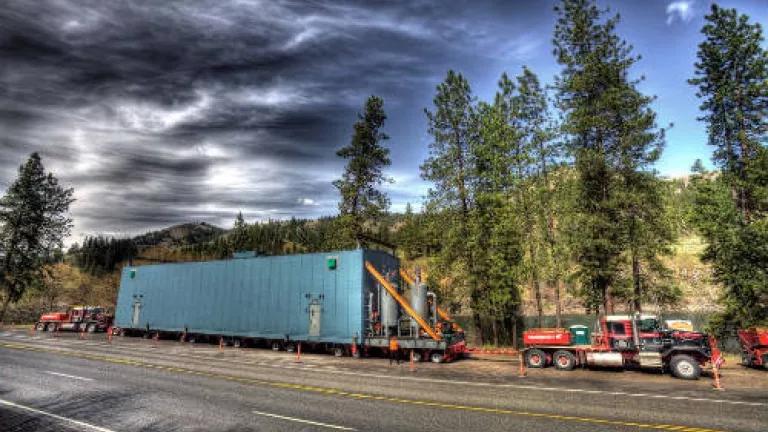
The original test module parked adjacent to the Clearwater River in Idaho. This shipment is currently parked indefinitely at Lolo Hot Springs, MT, with nowhere to go. Photo credit: Dave King
An interesting report emerged today regarding Exxon’s scheme to send “Megaload” tar sands mining equipment through the wild and scenic regions of Idaho and Montana. The item, an article from the industry focused website Industrial Fuels and Power, reported that the costs for Exxon’s Imperial Oil Kearl Oil Sands Project has increased to nearly $11 billion from an original company estimate of $8 billion (in Canadian $’s or CAD). The cause for this nearly $3 billion increase is more than partly attributable to the delays with the Megaload shipments. Without the mining equipment, it is looking increasingly difficult for Exxon to stick to the original plan for their tar sands expansion plans in Alberta:
“The problems with Kearl stem back to 2007-08 when Imperial made a decision to have giant modules made in South Korea, shipped to the Port of Vancouver, barged to Lewiston, Idaho, then trucked up through Idaho, Montana and up into Canada – simple…Imperial’s plan looks to have gone “belly up” as the final leg has been dogged with problems. Imperial thought it would easily get permits to shift the giant loads up highway 12, a backdrop of outstanding natural beauty and the setting of the film “A river runs through it.” But this has not proved to be the case and Imperial has faced a fierce battle at almost every turn.
Opposition to the mammoth oil sands loads has been fierce from environmental groups, local people and local authorities. Imperial, in the absence and availability of a plan B has now taken to dismantling the modules into smaller loads so they can be trucked up to Edmonton, Alberta and reassembled at an estimated cost of CAD500,000 a module.”
Today’s report follows a recent ruling by a Montana state judge that maintains a temporary injunction preventing Exxon from transporting Megaload shipments through the state. The court decision indefinitely delays Exxon's plans until a number of outstanding environmental issues are resolved.
What is remarkable about this latest news regarding the Megaload scheme is that Exxon, in all of its considerable arrogance, seemingly assumed that turning one of the most wild and scenic parts of the United States into an industrial transportation corridor was a fait accompli. But while developing these plans in secret, Exxon incomprehensibly failed to grasp how beloved this area is. Nor did they even appreciate, in a technical sense, how utterly incompatible this transportation proposal was in a region that only has one isolated and narrow high mountain pass.
“The lesson to be learned here is that Imperial seems to have made a plan without a viable alternative and looks to have resorted to crisis management on the ground to try and salvage something.”
While the fight to stop Exxon is far from complete, if there is another take-home lesson from these events, it’s that citizens can rise up and put a stop to these terrible schemes. Notably, NRDC members and activists have sent in thousands of letters and emails, and made countless calls to government officials voicing their opposition—and we have received direct feedback from a number of these officials that these messages were heard “loud and clear.” Furthermore, not enough can be said about the local citizens and organizations in Idaho and Montana, along with their attorneys, who went out on a limb to risk all in opposing Exxon. The fight to conserve our resources is a seemingly perpetual one, but the latest news about Exxon's Megaloads shows that these types of fights are definitely worth the effort.

